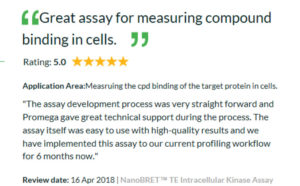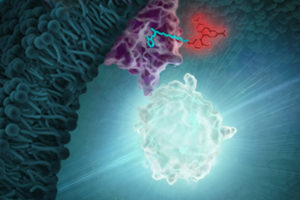Late in 2017, a group here at Promega launched an exciting new assay, the NanoBRET™ Target Engagement (TE) Intracellular Kinase Assay.
It’s easy for me to call this assay exciting; I was an editor on the project team. But judging by the reviews on the SelectScience® web site, others are excited about NanoBRET™ Target Engagement Intracellular Kinase Assay too.
Why the excitement? The NanoBRET TE Intracellular Kinase Assay fills a need for testing potency of compounds against specific kinase targets in a native setting, that is, in live cells.
Compound Potency: Why Does it Matter?
In a recent Journal of Medicinal Chemistry paper, Causes and Significance of Increased Compound Potency in Cellular or Physiological Contexts, Schwaid et al. call compound potency a “key metric” in medicinal chemistry research.
In target-based drug discovery, researchers involved in drug prospecting search for compounds with activity against their target of interest. Sometimes this is done by performing massive in vitro biochemical screens using purified proteins. This type of assay has advantages, but only provides information on biochemical potency of the compound. It does not provide any information on how the compound works in live cells.
Schwaid et al. note that compound potency can decrease or increase when moving from biochemical potency testing to cellular potency testing. They note that:
“Correctly interpreting and understanding compound potency in physiologically relevant settings is critical to compound development and understanding the compound’s mechanism of action.”
Potency Decreases Observed in Live Cells
In a Cell Chemical Biology paper Quantitative, Wide-Spectrum Kinase Profiling in Live Cells for Assessing the Effect of Cellular ATP on Target Engagement, Vasta et al. provide some explanations for decreases in potency, noting that: 1) biochemical assays frequently fail to test drug compounds against full-length protein targets; 2) extracellular assays fail to expose drug compounds to the permeability challenges of a cellular environment, and; 3) the presence of multiprotein complexes inside cells can affect a compounds ability to bind. These are just some of the factors that can affect a decrease in compound target binding when comparing results from a biochemical assay to an in-cell assay.
Potency Increases in Live Cells?
Schwaid et al. write:
“…potency measured with recombinant enzyme and potency measured in cell may not entirely coincide. Decreases in cellular vs. recombinant potency are often anticipated or explainable. What is less often realized is that compound potency can increase in a cellular environment…”.
These authors list several reasons why compound potency could increase in a cellular vs. a biochemical assay.
Post-translational modification of proteins can cause conformational changes, increasing exposure to drug compound binding sites on proteins, thus increasing compound potency over that seen with purified or recombinant proteins.
The concentration of a compound inside a cell is assumed to be uniform and equivalent to a fraction of the concentration applied to the cell. But cellular compartments can trap and conceal compound from the rest of the cell. Schwaid et al. used sunitinib as an example. This receptor tyrosine kinase inhibitor was originally approved for use in renal cell carcinoma treatment.
Lysosomal sequestration has been shown to both increase and decrease sunitinib potency for its protein targets. While sunitinib accumulates in the lysosome, its targets, VEGFR2 and PDGR2 are cytosolic. One means of tumor resistance has been to increase the number of lysosomes in cells, which in turn increases concentration of sunitinib, although not its efficacy. On the other hand, sunitinib can induce cell death through lysosomal death pathways, by inhibiting sphingomyelinase activity, increasing lysosome permeability.
Other compounds can play a role in increasing potency in cells, through drug-drug interactions. Chloroquine treatment increases lysosomal pH and can thus influence the potency of sunitinib sequestered in lysosomes.
Perhaps most importantly, Schwaid et al. note that it is possible to discard a compound due to poor binding results with recombinant proteins in a noncellular assay, when the compound might respond more favorably to the target in an intracellular assay.
Better Techniques to Measure Cell Potency
Schwaid et al. note that “as better techniques to measure target occupancy in cells are developed”, compound potency increases in cellular environments will ultimately lead to better understanding of factors responsible for increased potency and “improvements in prediction of in vivo binding potency”.
The NanoBRET™ TE Intracellular Kinase Assays measure compound potency and occupancy for specific kinase targets in live cells, and these assays will help address a critical need in the development of new drug molecules. The scientists that developed these assays used them to study many compounds including drugs already in clinical use, such as dasatinib (Vasta et al.). Consistent with the Schwaid report, Vasta et al. observed using dasatanib that the NanoBRET TE assay cellular potencies relative to reported biochemical potencies could be decreased for certain targets, and increased with other targets. Equally exciting was the observation that dasatinib had improved selectivity in live cells compared to previous reports that used dasatinib in biochemical assays.
Here are the papers:
Schwaid et al. (2017) Causes and significance of increase compound potency in cellular or physiological contexts. J. Med. Chem. 61, 1767–73.
Vasta et al. (2017) Quantitative, wide-spectrum kinase profiling in live cells for assessing the effect of cellular ATP on target engagement. Cell Chem. Biol. 25, 206–14.
Kari Kenefick
Latest posts by Kari Kenefick (see all)
- Cell-Based Target Engagement and Functional Assays for NLRP3 Inhibitor Profiling Help Identify Successes and Failures - January 25, 2024
- Illuminating the Brain with a New Bioluminescence Imaging Substrate - April 13, 2023
- Made Just for You: Promega Custom Reagents - October 28, 2022


